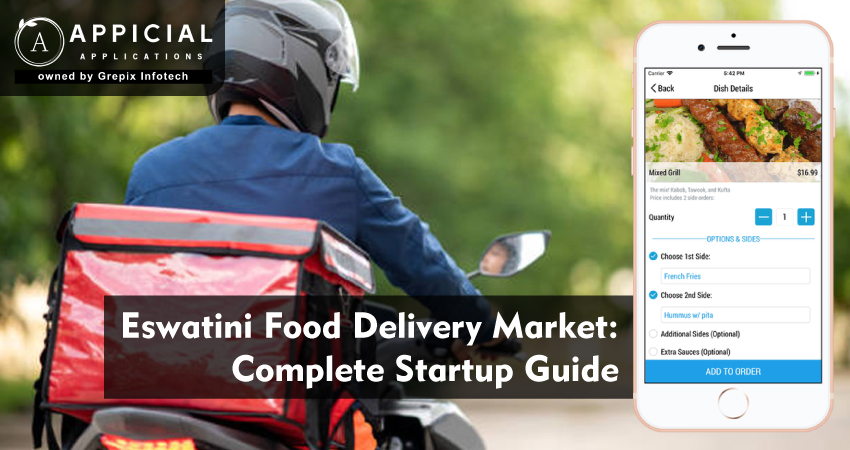
Eswatini Food Delivery Market: Complete Startup Guide
Sipho was tired. It was past 8 PM in Mbabane. The streets were quiet, the shops closing, and the city lights reflecting off the hills. He had spent the day running errands, stuck in traffic along Somhlolo Road, and he just wanted one thing: a hot dinner.
But there was a problem. The few restaurants open didn’t offer delivery. No one picked up the phone reliably. The small local food delivery app he heard about wasn’t working properly. Sipho sighed.
He thought aloud:
"If Johannesburg has reliable delivery apps, if Cape Town is thriving with food ordering apps, why can’t Eswatini have something similar? Why can’t we have a proper food delivery app here?"
That thought planted a seed. For entrepreneurs, these small frustrations are gold mines. Sipho’s story reflects what many Eswatini residents feel: hunger, convenience, and opportunity all wrapped in one.
This guide will take you on a journey, from understanding the Eswatini food delivery market to building your startup, step by step. By the end, you’ll see why investing in a food delivery app development company like Appicial Applications could be your fastest route to success.
This guide explores the rise of food delivery apps in Eswatini. From Sipho’s struggle to find dinner in Mbabane to a step-by-step startup roadmap, it explains the costs, challenges, and revenue model for launching delivery apps in 2025. It covers local adaptation, marketing strategies, and how food delivery app development can scale your business. The blog also highlights why Appicial Applications is the best food delivery app development company to partner with.
Why Start a Food Delivery App in Eswatini?
Life in Eswatini is busy. Urban areas like Mbabane and Manzini are growing fast. Students, office workers, and families want convenience. But options for home delivery remain limited.
Here’s why the food delivery market in Eswatini is promising:
- Smartphone use is rising. Almost everyone carries a device.
- Mobile payments are becoming common. EcoCash and banks support digital transactions.
- Urban population is growing; busy residents crave convenience.
- Competition for food delivery apps is minimal.
Imagine a user opening a Doordash delivery app style platform in Mbabane and ordering pizza, traditional dishes, or drinks in a single tap. Or a local tea shop reaching students through a simple food ordering app. These are the gaps your startup can fill.
What Exactly is a Food Delivery App in Eswatini?
Globally, we know platforms like Grubhub delivery and Doordash food delivery dominate. But in Eswatini, success means local adaptation. A food delivery app must:
- Offer menus in English and siSwati.
- Connect urban and peri-urban areas like Mbabane, Manzini, and Matsapha.
- Include small restaurants, maquis, and street vendors.
The core model remains: connect customers, drivers, and restaurants via delivery apps. But local flavor and convenience make all the difference.
How to Start a Food Delivery App Business in Eswatini
People often ask: “How can I launch a food delivery app in Eswatini without experience?”
Here’s the roadmap.
1 Identify Market Gaps
Sipho started by observing:
- Most restaurants in Mbabane didn’t deliver.
- Delivery options were slow or unreliable.
- Students and office workers struggled to get meals during lunch or dinner.
This observation became his unique selling point.
2 Conduct Local Research
Sipho didn’t rely on online surveys. He walked through:
- Restaurants and cafes in Manzini and Matsapha.
- Street vendors and local tea shops.
- University campuses in Mbabane.
Questions he asked:
- Would you use a food delivery app?
- Are you willing to pay a delivery fee?
- Do you trust online payments like EcoCash?
Most answered yes—if the platform was reliable and affordable.
3 Legal and Compliance Setup
Even in 2025, Eswatini requires formal setup:
- Register your business with Eswatini’s commercial registry.
- Acquire the necessary permits for delivery services.
- Ensure compliance with digital payments.
- Draft contracts with restaurants and drivers.
4 Budget Your Startup
Launching a food delivery app requires planning:
- Food delivery app development: $20k–$50k.
- Marketing in Mbabane: $5k–$10k. Flyers, social media campaigns, radio ads.
- Staff and operations: $1.5k–$3k/month.
- Driver incentives: $1k–$3k initially.
In total, expect $30k–$60k to start lean but scalable.
5 Build Your Food Delivery App
The app must:
- Work on low-speed internet.
- Be simple and lightweight.
- Support EcoCash, bank cards, and cash payments.
- Include GPS for tracking.
Sipho considered building from scratch. But then he found Appicial Applications, a leading food delivery app development company. They offered ready-made food delivery app development solutions tailored to Eswatini. He saved months of development and went to market fast.
6 Recruit Restaurants and Drivers
Without restaurants, your delivery apps are useless. Without drivers, no deliveries happen.
Sipho approached:
- Small family-run restaurants in Mbabane.
- Street food vendors in Manzini.
- Drivers with motorbikes or small cars.
He offered incentives, marketing exposure, and mobile payment convenience. Soon, he had a robust network for his food delivery app.
Also Read: Driving to Wealth: How to Become a Billionaire in South Africa's Taxi Business
7 Marketing the Launch
Even the best food ordering apps fail without users. Sipho used:
- Flyers and posters at universities and bus stations.
- Social media: Facebook, Instagram ads targeting urban youth.
- Collaboration with local food bloggers.
- First-order promotions and discounts.
Orders grew steadily, turning his small network into a thriving business.
8 Expand Beyond Mbabane
After stabilizing in Mbabane, Sipho looked at Manzini, Matsapha, and Ezulwini. The urban-rural connectivity potential is huge. With the right food delivery app development company, scaling across towns becomes feasible.
How Do Food Delivery Apps in Eswatini Make Money?
Revenue streams include:
- Restaurant commissions: 15–25% per order.
- Delivery fees: collected from customers.
- Advertising: featured restaurant listings.
- Subscription plans: free delivery or premium service.
Global models like Grubhub delivery, DoorDash food delivery, and the DoorDash delivery app show this works. The same model fits Eswatini perfectly.
What Challenges Exist in Eswatini?
Running food delivery apps in Eswatini comes with challenges:
- Unstable internet in peri-urban towns.
- Cash payments still dominate.
- Convincing traditional restaurants to join.
- Logistics for drivers in less accessible areas.
Patience, proper marketing, and strong partnerships can overcome all of these.
Future Trends of Food Delivery in Eswatini
Looking ahead to 2025:
- AI in food delivery apps → predicting popular meals.
- Super apps → combining food ordering apps, taxi, groceries, and courier services.
- Drone delivery → futuristic but plausible.
- Expansion of mobile payments → fueling food delivery app development growth.
Eswatini is ready for a delivery apps revolution. Entrepreneurs who start now can dominate the market.
Why Appicial Applications Is the Smart Partner?
Sipho’s idea stayed a dream until he partnered with Appicial Applications, a leading food delivery app development company. They provided:
- Ready-made food delivery apps.
- Customization for local language and culture.
- GPS tracking and mobile payments.
- Complete platforms for restaurants, drivers, and customers.
Whether you want a platform similar to the DoorDash delivery app or the Grubhub delivery app, Appicial makes it fast, affordable, and scalable.
Conclusion
Starting a food delivery app business in Eswatini is no longer just an idea; it’s a profitable opportunity. The urban population, smartphone adoption, and mobile payments create fertile ground for delivery apps growth. By partnering with a reliable food delivery app development company like Appicial Applications, entrepreneurs can launch quickly, scale efficiently, and capture a market that is wide open in 2025.
FAQs
Author's Bio

Vinay Jain is the Founder at Grepix Infotech and brings over 12 years of entrepreneurial experience. His focus revolves around software & business development and customer satisfaction.
Back to blog list





